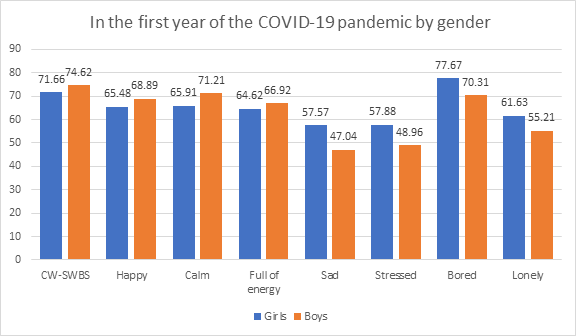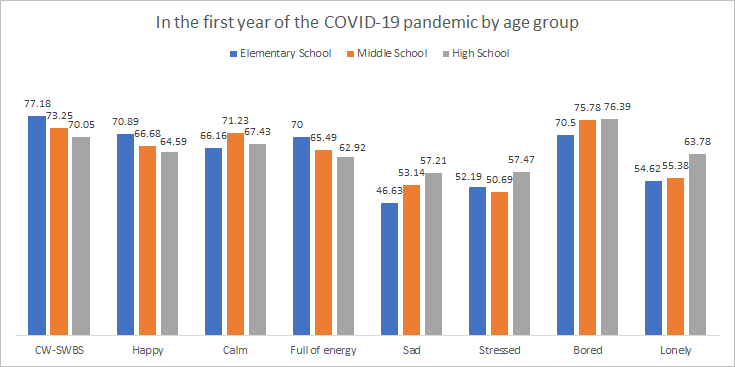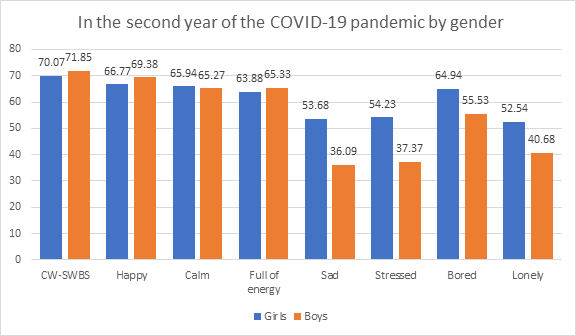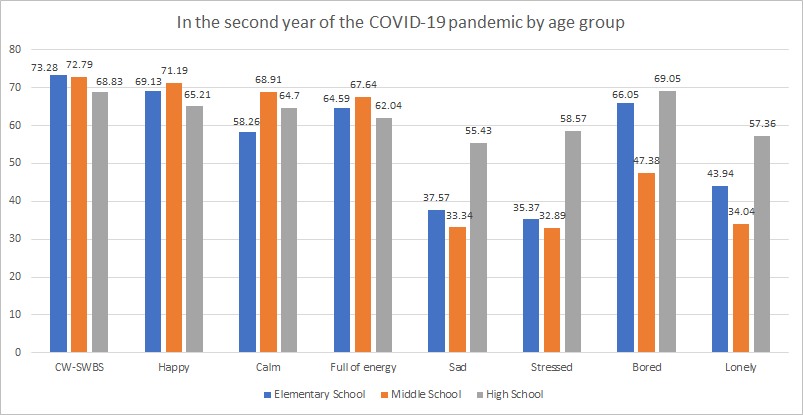On 11 March 2020, the WHO declared COVID-19 to be a pandemic (WHO, 2020). Studies on children's subjective well-being (SWB) in Indonesia during the COVID-19 pandemic are still limited. In fact, in mid-2020, Indonesia became the country with the highest number of confirmed COVID-19 cases in Southeast Asia (Nurbaiti, 2020) with a high reported COVID-19 death rate among children (Nurbaiti & Syakriah, 2020). As a response to the situation, the Education and Culture Minister called on teachers, parents, and students to stay at home and practice remote learning (Pangestika, 2020). Schools were closed, and as a result, children experienced changes in their daily life routines. They had to stay at home and could not meet with their friends. With children confined to home, many were unable to play outside or meet with their friends (UNICEF, 2020). A study in Indonesia reported that children were bored due to lack of various physical activities, dissatisfied with school closures and with what they learned at home, and dissatisfied at not being able to meet with friends during periods of school closure (Borualogo & Casas, 2021).
Participants
As shown by the fact that they had use of internet facilities, it is obvious that the participants live in families of medium to high socioeconomic background. In the survey made in the first year of the COVID-19 pandemic (May to July 2020), 58.3% of the participants were girls and 41.7% were boys. In the second year of the COVID-19 pandemic (March to May 2021), 44.9% of the surveyed participants were girls and 55.1% were boys.
Instruments
Children's Worlds Subjective Well-Being ScaleBoth studies used the Children's Worlds Subjective Well-Being Scale (CW-SWBS) which was translated and validated into Indonesian (Borualogo et al., 2019; Borualogo & Casas, 2019). The CW-SWBS5 includes five items with an 11-point scale from 0 (do not agree at all) to 10 (totally agree). The items are: (1) "I enjoy my life," (2) "My life is going well," (3) "I have a good life," (4) "The things happening in my life are excellent," and (5) "I am happy with my life."
Positive affect (PA) and negative affect (NA) scaleThe Children's Worlds Positive and Negative Affect Scale (CW-PNAS) included three items on PA (feeling happy, calm, and full of energy) and four items on NA (feeling sad, stressed, bored, and lonely). The CW-PNAS was translated into the Indonesian language. The CW-PNAS evaluates children's feelings over the previous two weeks on a scale of 0-10 (Casas & Gonzalez-Carrasco, 2021).
Satisfaction items during the COVID-19 pandemicTwo items were used to measure satisfaction during the COVID-19 pandemic, one item having a slightly different wording from the other. In the first year of the COVID-19 pandemic, children were asked how satisfied they were with the contact they had with friends during the pandemic. In the second year of the pandemic, children were asked how satisfied they were with the communication they had with friends during the COVID-19 pandemic. In both studies, they were also asked how satisfied they were with how they spent their time during the pandemic. The options were 0 to 10 (0=Not at all satisfied to 10=Totally satisfied).
Family incomeIn the first year of the COVID-19 pandemic, the item asking about family income was "During the last month, how worried are you about the money your family has?" This item was on an 11-point scale from 0 (not worried at all) to 10 (extremely worried). In the second year of the COVID-19 pandemic, the item question was "During COVID-19, how often do you worry about how much money your family has?" The answers were Never=1, Sometimes=2, Often=3, and Always=4.
Results
In the first year of the COVID-19 pandemicThose who were extremely worried about their family's financial situation accounted for 27.3% of the participants, and only 2.2% of the participants were not worried at all. Boys (M=74.62; SD=19.16) displayed significantly higher mean scores than girls (M=71.66; SD=21.84) on the CW-SWBS and all the PA items (feeling happy, calm, and full of energy), while girls displayed higher mean scores than boys on all the NA items (feeling sad, stressed, bored, and lonely). High school students reported higher scores on NA than elementary and middle school students. Elementary students displayed significantly higher mean scores than middle and high school students on CW-SWBS, the items feeling happy and full of energy. Middle school students displayed significantly higher mean scores on calmness than elementary and high school students. Girls are more susceptible to sadness, stress, boredom, and loneliness, while boys are less susceptible to negative affect and able to remain calm.

 In the second year of the COVID-19 pandemic
In the second year of the COVID-19 pandemic
The percentage of children who sometimes worried about their family financial situation accounted for 43.0% of participants, and 12.3% of them were always worried. Boys were significantly happier and more satisfied with their time use than girls, while girls were feeling significantly sadder, more stressed, more bored, and lonelier than boys. Significant differences were also observed between school grades for all variables, apart from satisfaction over communication with friends and satisfaction with the use of time. Elementary students reported significantly higher CW-SWBS mean scores than middle school and high school students. In addition, elementary students (M=73.28; SD=19.79) showed a higher mean score for the CW-SWBS than middle school (M= 72.79; SD=25.99) and high school students (M= 68.83; SD= 24.97). High school students reported significantly higher scores on NA than elementary and middle school students. These results indicated that during the second year of the COVID-19 pandemic in Indonesia, high school students were feeling sadder, more stressed, more bored, and lonelier than elementary and middle school students. Middle school students displayed significantly higher mean scores on PA (feeling happy, calm, and full of energy) than elementary and high school students. School grade significantly contributed to participants' SWB, all NA items, happy and full of energy and being calm in both studies, and only in the second year of the COVID-19 pandemic. Being a younger child increases the probability of feeling happier, full of energy, being calm and displaying higher SWB. Being an older child increases the probability of all negative affect items in both studies only in the second year of the COVID-19 pandemic.


Moreover, in the second year of the COVID-19 pandemic, 54.1% of children reported that they were able to meet in person with their friends. A study conducted by UNICEF (2021) in Indonesia reported that children were required to meet COVID-19 health protocol requirements (e.g., wearing a mask, having temperature taken, washing hands) when attending school and meeting with their friends at school. Satisfaction with communication with friends contributed negatively to feeling lonely only in the second year of the COVID-19 pandemic.
In the first and second year of the COVID-19 pandemic, WhatsApp was the most frequent mode of communication that children used to keep in contact with their friends, followed by video calls (61.2%) in the first year of the COVID-19 pandemic and Instagram (55.2%) in the second year of the pandemic. In the second year of the pandemic, 54.0% of children reported meeting in person with friends. In the first year of the COVID-19 pandemic, only 14.4% of children reported spending time in the neighbourhood, but this increased to 37.2% in the second year of the COVID-19 pandemic.
Discussion
Regarding the first aim of this study, to examine children's SWB by gender and school grade, results showed that during the COVID-19 pandemic, boys displayed significantly higher CW-SWBS mean scores than girls in the first year of the COVID-19 pandemic, while elementary students displayed significantly higher on the CW-SWBS mean scores than middle and high school students for both studies. The current study also showed that girls displayed a higher probability of feeling negative affects than boys.
In the first and second year of the COVID-19 pandemic, results showed that elementary students displayed significantly higher CW-SWBS mean scores than middle and high school students, while high school students displayed the lowest CW-SWBS mean scores in both the first year and second year of the COVID-19 pandemic. These results suggest that the older the children, the lower their CW-SWBS mean scores were during the COVID-19 pandemic. Results also revealed that the older the children, the higher their probability of feeling sad, stressed, bored, and lonely in both studies.
Moreover, the CW-SWBS scores in the second year of the COVID-19 pandemic were lower than the CW-SWBS scores in the first year of the pandemic. This result suggests that these CW-SWBS scores were lower than the mean set-point of SWB according to Cummins' criteria (2014).
Children and adolescents participating in the first year of the COVID-19 pandemic displayed lower mean negative affect scores than those in the second year of the COVID-19 pandemic. These results suggest that the children and adolescents surveyed in the second year of the pandemic had adapted to the unpleasant situation, and buffers were activated to protect them from greater negative affect, as defended by the homeostasis theory (Cummins, 2014). Two buffers were activated in the process of adapting to the unpleasant situations during the COVID-19 pandemic: (1) having relationships with friends and (2) engaging in purposeful activities (Cummins, 2014). Their satisfaction over contact or communication with friends and satisfaction with time used to choose purposeful activities protected their SWB. Regarding satisfaction with life during the COVID-19 pandemic, both studies show significant school grade differences in satisfaction with their contact with friends.
Elementary students reported significantly lower satisfaction in this category than middle school and high school students. Satisfaction with use of time contributed negatively to negative affects only in the first year of the COVID-19 pandemic. Participants may not have been able to participate in various activities during the lockdown, which resulted in them being more bored and less satisfied with use of time. It indicates that children's freedom to choose their daily activities contributed to the results in the first and second year of the COVID-19 showing that boys displayed significantly higher mean scores on feeling happy than girls, while girls displayed significantly higher mean scores on NA than boys in both studies. This suggests that girls were sadder, more stressed, more bored, and lonelier than boys during the pandemic in both studies, while boys were happier and calmer in the first year of the COVID-19 pandemic and happier in the second year of the COVID-19 pandemic than girls.
The results from the first year of the COVID-19 pandemic indicated that elementary students felt significantly happier and had more energy than middle and high school students. In contrast, high school students were significantly sadder, more stressed, more bored, and lonelier than elementary and middle school students, and middle school students were significantly calmer than elementary and high school students.
The results from the second year of the COVID-19 pandemic showed that middle school students felt significantly happier, calmer, and had more energy than elementary and high school students. In contrast, high school students felt sadder, more stressed, more bored, and lonelier than elementary and middle school children.
Regarding satisfaction with life during the COVID-19 pandemic, both studies show significant school grade differences in satisfaction with their contact with friends. Elementary students reported significantly lower satisfaction in this category than middle school and high school students.
Regarding the COVID-19 pandemic, children were restricted from meeting with their friends in person; however, they could still use Internet-based modes of communication to maintain contact. Moreover, in the second year of the COVID-19 pandemic, 54.1% of children reported that they could meet in person with their friends. A study conducted by UNICEF (2021) in Indonesia reported that children were required to meet COVID-19 health protocol requirements (e.g., wearing a mask, having temperature taken, washing hands) when attending school and meeting with their friends at school.
Conclusion
The survey results from the first- and second-year show that the COVID-19 pandemic had consequences on the SWB of Indonesian children. Girls displayed significantly lower SWB and higher mean scores for NA than boys, which suggests that girls were less happy than boys during the COVID-19 pandemic in Indonesia. Results also displayed significant school grade differences, whereby the older the children, the lower their SWB. Older children also reported higher NA scores than younger children. Results in the second year of the pandemic showed lower CW-SWBS scores both by gender and school grade compared to results in the first year, suggesting that Indonesian children were less happy in the second year of the COVID-19 pandemic. Under situations like the pandemic, parents should allow children to maintain contact with their friends through online-based communication since the children's satisfaction was higher in the second year when there was contact with friends using online-based communication. Parents should also allow children to do more physical activities during the COVID-19 pandemic to increase their SWB and help them stay on course at home.
References
- Borualogo, I. S., & Casas, F. (2019). Adaptation and validation of the Children's Worlds Subjective Well-Being Scale (CW-SWBS) in Indonesia. Jurnal Psikologi, 46(2), 102-116. https://doi.org/10.22146/jpsi.38995
- Borualogo, I. S., Gumilang, E., Mubarak, A., Khasanah, A. N., Wardati, M. A., Diantina, F. P., Permataputri, I., & Casas, F. (2019). Process of translation of the Children's Worlds Subjective Well-Being Scale in Indonesia. Proceedings of the Social and Humaniora Research Symposium (SoRes 2018) - Advances in Social Science, Education and Humanities Research, 307, 180-183. https://doi.org/10.2991/sores-18.2019.42
- Borualogo, I. S., & Casas, F. (2021). Children and adolescents' report on their quality of life during COVID-19 pandemic. Psikohumaniora, 6(2), 153-170. https://doi.org/10.21580/pjpp.v6i2.8572
- Casas, F., & Gonzalez-Carrasco, M. (2021). Analysing comparability of four multi-item well-being psychometric scales among 35 countries using Children's Worlds 3rd wave 10 and 12-year-olds samples. Child Indicator Research, 14, 1829-1861. https://doi.org/10.1007/s12187-021-09825-0
- Cummins, R. A. (2014). Understanding the well-being of children and adolescents through homeostatic theory. In A. Ben-Arieh, F. Casas, I. Frones, & J. E. Korbin (Eds.), Handbook of child wellbeing: Theories, methods and policies in global perspective (pp. 635-662). Springer. https://doi.org/10.1007/978-90-481-9063-8_152
- Nurbaiti, A. (2020, June 17). Indonesia becomes country with most confirmed COVID-19 cases in Southeast Asia. The Jakarta Post. Retrieved June 12, 2021, from https:// www.thejakartapost.com/news/2020/06/17/indonesia-becomes-country-with-most-confirmed-covid-19-cases-in-southeast-asia.html
- Nurbaiti, A., & Syakriah, A. (2020, September 3). Indonesia reports higher COVID-19 death rate among children than United States. The Jakarta Post. Retrieved June 21, 2021, from https://www.thejakartapost.com/news/2020/09/03/indonesia-reports-highercovid-19-death-rate-among-children-than-united-states.html
- Pangestika, D. (2020, March 17). Education minister Nadiem Makarim calls on people to stay at home. The Jakarta Post. Retrieved June 21, 2021, from https://www.thejakartapost.com/news/2020/03/17/education-minister-nadiem-makarim-calls-on-people-to-stay-at-home.html
- UNICEF (2020). COVID-19 and children in Indonesia: An agenda for action to address socio-economic challenges. UNICEF Indonesia. Retrieved June 12, 2021, from https://www.unicef.org/indonesia/reports/covid-19-and-children-in-indonesia
- UNICEF (2021). One year on COVID-19 through the eyes of children. UNICEF Indonesia. Retrieved June 12, 2021, from https://www.unicef.org/indonesia/media/9396/file/One%20year%20on:%20COVID-19%20through%20the%20eyes%20of%20children.pdf
- WHO (2020b, June 29). Timeline: WHO's COVID-19 response. Retrieved June 12, 2021, from https://www.who.int/emergencies/diseases/novel-coronavirus-2019/interactive-timeline



 Ihsana Sabriani Borualogo
Ihsana Sabriani Borualogo










